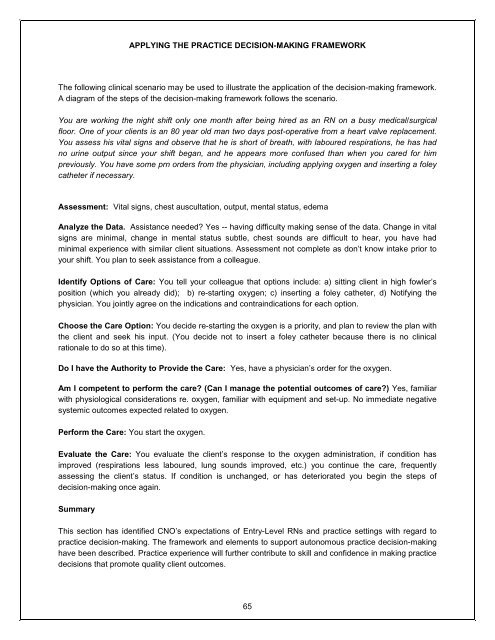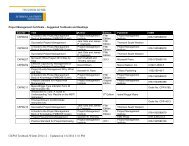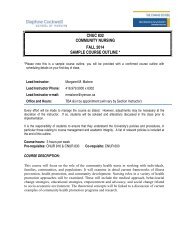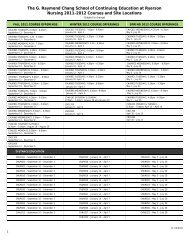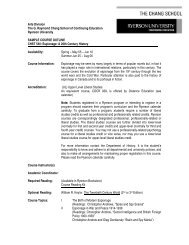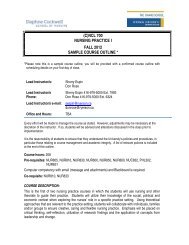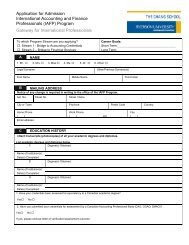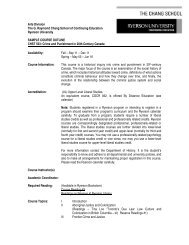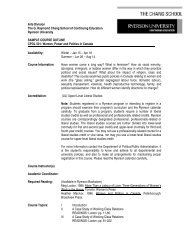School of Nursing - The Chang School - Ryerson University
School of Nursing - The Chang School - Ryerson University
School of Nursing - The Chang School - Ryerson University
You also want an ePaper? Increase the reach of your titles
YUMPU automatically turns print PDFs into web optimized ePapers that Google loves.
APPLYING THE PRACTICE DECISION-MAKING FRAMEWORK<br />
<strong>The</strong> following clinical scenario may be used to illustrate the application <strong>of</strong> the decision-making framework.<br />
A diagram <strong>of</strong> the steps <strong>of</strong> the decision-making framework follows the scenario.<br />
You are working the night shift only one month after being hired as an RN on a busy medical/surgical<br />
floor. One <strong>of</strong> your clients is an 80 year old man two days post-operative from a heart valve replacement.<br />
You assess his vital signs and observe that he is short <strong>of</strong> breath, with laboured respirations, he has had<br />
no urine output since your shift began, and he appears more confused than when you cared for him<br />
previously. You have some prn orders from the physician, including applying oxygen and inserting a foley<br />
catheter if necessary.<br />
Assessment: Vital signs, chest auscultation, output, mental status, edema<br />
Analyze the Data. Assistance needed? Yes -- having difficulty making sense <strong>of</strong> the data. <strong>Chang</strong>e in vital<br />
signs are minimal, change in mental status subtle, chest sounds are difficult to hear, you have had<br />
minimal experience with similar client situations. Assessment not complete as don’t know intake prior to<br />
your shift. You plan to seek assistance from a colleague.<br />
Identify Options <strong>of</strong> Care: You tell your colleague that options include: a) sitting client in high fowler’s<br />
position (which you already did); b) re-starting oxygen; c) inserting a foley catheter, d) Notifying the<br />
physician. You jointly agree on the indications and contraindications for each option.<br />
Choose the Care Option: You decide re-starting the oxygen is a priority, and plan to review the plan with<br />
the client and seek his input. (You decide not to insert a foley catheter because there is no clinical<br />
rationale to do so at this time).<br />
Do I have the Authority to Provide the Care: Yes, have a physician’s order for the oxygen.<br />
Am I competent to perform the care? (Can I manage the potential outcomes <strong>of</strong> care?) Yes, familiar<br />
with physiological considerations re. oxygen, familiar with equipment and set-up. No immediate negative<br />
systemic outcomes expected related to oxygen.<br />
Perform the Care: You start the oxygen.<br />
Evaluate the Care: You evaluate the client’s response to the oxygen administration, if condition has<br />
improved (respirations less laboured, lung sounds improved, etc.) you continue the care, frequently<br />
assessing the client’s status. If condition is unchanged, or has deteriorated you begin the steps <strong>of</strong><br />
decision-making once again.<br />
Summary<br />
This section has identified CNO’s expectations <strong>of</strong> Entry-Level RNs and practice settings with regard to<br />
practice decision-making. <strong>The</strong> framework and elements to support autonomous practice decision-making<br />
have been described. Practice experience will further contribute to skill and confidence in making practice<br />
decisions that promote quality client outcomes.<br />
65


